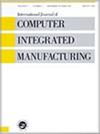Extending factory digital Twins through human characterisation in Asset Administration Shell
IF 3.7
3区 工程技术
Q2 COMPUTER SCIENCE, INTERDISCIPLINARY APPLICATIONS
International Journal of Computer Integrated Manufacturing
Pub Date : 2023-11-11
DOI:10.1080/0951192x.2023.2278108
引用次数: 0
Abstract
This paper extends the traditional factory digital twins by incorporating human characterisation in Asset Administration Shell (AAS). The extension lays the basis for human-centred control and management, as demonstrated by employing a prototype of the extended AAS in two proposed use cases. Referred to Industry 5.0, an accurate digital representation of humans as a basis of the data-based decision support to improve operators’ well-being and resilience. The AAS is extended to include dedicated digital models accommodating a set of properties to describe the human operators and its interactions with the surrounding shop-floor resources. Two reference use cases have been designed in the context of a complete lab-scale manufacturing system: equipment and devices have been modelled according to the AAS standard, exposing information via MQTT, and have been integrated with the proposed AAS definition of human operators. Operators have been equipped with wearable sensors and a dashboard providing them with feedback from the manufacturing environment and notifications about changes. As part of the extension process, some ethical and regulation concerns are discussed, highlighting that the extended AAS is mature enough to support the inclusion of human operators, but regulations struggle to keep up with technological advances.通过资产管理Shell中的人类特征扩展工厂数字孪生
本文通过在资产管理Shell (AAS)中引入人的特征来扩展传统的工厂数字孪生。扩展为以人为中心的控制和管理奠定了基础,正如在两个建议用例中使用扩展AAS的原型所演示的那样。参考工业5.0,人类的精确数字表示作为基于数据的决策支持的基础,以提高操作人员的福祉和应变能力。AAS扩展到包含专用的数字模型,以容纳一组属性来描述人工操作员及其与周围车间资源的交互。在完整的实验室规模制造系统的上下文中设计了两个参考用例:根据AAS标准对设备和设备进行建模,通过MQTT公开信息,并与拟议的AAS人工操作员定义集成。操作人员配备了可穿戴传感器和仪表板,为他们提供制造环境的反馈和变化通知。作为扩展过程的一部分,讨论了一些道德和监管问题,强调扩展的AAS已经足够成熟,可以支持包括人类操作员,但法规难以跟上技术进步。
本文章由计算机程序翻译,如有差异,请以英文原文为准。
求助全文
约1分钟内获得全文
求助全文
来源期刊
CiteScore
9.00
自引率
9.80%
发文量
73
审稿时长
10 months
期刊介绍:
International Journal of Computer Integrated Manufacturing (IJCIM) reports new research in theory and applications of computer integrated manufacturing. The scope spans mechanical and manufacturing engineering, software and computer engineering as well as automation and control engineering with a particular focus on today’s data driven manufacturing. Terms such as industry 4.0, intelligent manufacturing, digital manufacturing and cyber-physical manufacturing systems are now used to identify the area of knowledge that IJCIM has supported and shaped in its history of more than 30 years.
IJCIM continues to grow and has become a key forum for academics and industrial researchers to exchange information and ideas. In response to this interest, IJCIM is now published monthly, enabling the editors to target topical special issues; topics as diverse as digital twins, transdisciplinary engineering, cloud manufacturing, deep learning for manufacturing, service-oriented architectures, dematerialized manufacturing systems, wireless manufacturing and digital enterprise technologies to name a few.

 求助内容:
求助内容: 应助结果提醒方式:
应助结果提醒方式:


